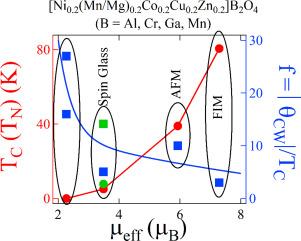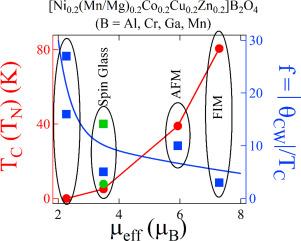新型铝基、镓基和锰基高熵氧化物的结构、拉曼光谱和磁特性
IF 5.6
2区 材料科学
Q1 MATERIALS SCIENCE, CERAMICS
引用次数: 0
摘要
高熵氧化物(HEOs)作为材料研究领域前景广阔的前沿技术,其最新进展引发了人们的极大兴趣,彻底改变了材料设计和性能的面貌。高熵氧化物具有出色的稳定性、引人入胜的功能特性以及无与伦比的设计灵活性,这些都得益于在这些材料中加入了多种阳离子。在这项研究中,我们成功稳定了几种新的高熵尖晶石氧化物,其成分为 (Ni0.2(Mg/Mn)0.2Co0.2Cu0.2Zn0.2)B2O4(B = Al、Ga、Mn)。室温 X 射线衍射(RT-XRD)、场发射扫描电子显微镜(FE-SEM)和能量色散光谱(EDS)测量结果表明,这些材料的晶体结构在微观尺度上具有极佳的化学均匀性。RT-XRD 和拉曼光谱证实了单相立方尖晶石结构的形成。然而,锰基样品表现出四方畸变。磁性测量显示磁性能存在显著差异:(Ni0.2Mg0.2Co0.2Cu0.2Zn0.2)Mn2O4 显示出复杂的铁磁行为,而基于铝和镓的金刚石晶格 (Ni0.2Mg0.2Co0.2Cu0.2Zn0.2)B2O4 (B = Al 和 Ga) 材料显示出极高的磁沮度,在低至 1.8 K 的温度下没有磁有序,表明存在奇异的沮度状态。在(Ni0.2Mn0.2Co0.2Cu0.2Zn0.2)B2O4(B = Al 和 Ga)材料中观察到了磁跃迁(类似自旋玻璃)。我们的研究强调了通过成分工程精细调节磁响应的潜力,从而为开发适用于各种应用的定制磁性材料铺平了道路。本文章由计算机程序翻译,如有差异,请以英文原文为准。


Structure, Raman spectroscopy, and magnetic properties of new Al, Ga, and Mn-based high entropy oxides
Recent advancements in high entropy oxides (HEOs) have sparked significant interest as a promising frontier in materials research, revolutionizing the landscape of material design and properties. They exhibit outstanding stability, intriguing functional properties, and unparalleled design flexibility enabled by the inclusion of multiple cations in these materials. In this study, we successfully stabilized several new high entropy spinel oxides with compositions (Ni0.2(Mg/Mn)0.2Co0.2Cu0.2Zn0.2)BO (B = Al, Ga, Mn). The room temperature X-ray diffraction (RT-XRD), field emission scanning electron microscopy (FE-SEM), and energy dispersive spectroscopy (EDS) measurements highlight the crystal structure of the materials with excellent chemical homogeneity at the micro-scale. RT-XRD and Raman spectroscopy confirmed the formation of single-phase cubic spinel structures. However, the Mn-based sample exhibited tetragonal distortion. Magnetic measurements show remarkable variation in the magnetic properties: (Ni0.2Mg0.2Co0.2Cu0.2Zn0.2)MnO shows complex ferrimagnetic behavior, Al and Ga based diamond lattice (Ni0.2Mg0.2Co0.2Cu0.2Zn0.2)BO (B = Al and Ga) materials revealed extremely high magnetic frustration and absence of magnetic ordering down to 1.8 K, indicative of exotic frustrated state. Magnetic transitions (spin-glass like) are observed in (Ni0.2Mn0.2Co0.2Cu0.2Zn0.2)BO (B = Al and Ga) materials. Our study highlights the potential to finely tune the magnetic responses through compositional engineering, thus paving the way for the development of tailored magnetic materials for various applications.
求助全文
通过发布文献求助,成功后即可免费获取论文全文。
去求助
来源期刊

Ceramics International
工程技术-材料科学:硅酸盐
CiteScore
9.40
自引率
15.40%
发文量
4558
审稿时长
25 days
期刊介绍:
Ceramics International covers the science of advanced ceramic materials. The journal encourages contributions that demonstrate how an understanding of the basic chemical and physical phenomena may direct materials design and stimulate ideas for new or improved processing techniques, in order to obtain materials with desired structural features and properties.
Ceramics International covers oxide and non-oxide ceramics, functional glasses, glass ceramics, amorphous inorganic non-metallic materials (and their combinations with metal and organic materials), in the form of particulates, dense or porous bodies, thin/thick films and laminated, graded and composite structures. Process related topics such as ceramic-ceramic joints or joining ceramics with dissimilar materials, as well as surface finishing and conditioning are also covered. Besides traditional processing techniques, manufacturing routes of interest include innovative procedures benefiting from externally applied stresses, electromagnetic fields and energetic beams, as well as top-down and self-assembly nanotechnology approaches. In addition, the journal welcomes submissions on bio-inspired and bio-enabled materials designs, experimentally validated multi scale modelling and simulation for materials design, and the use of the most advanced chemical and physical characterization techniques of structure, properties and behaviour.
Technologically relevant low-dimensional systems are a particular focus of Ceramics International. These include 0, 1 and 2-D nanomaterials (also covering CNTs, graphene and related materials, and diamond-like carbons), their nanocomposites, as well as nano-hybrids and hierarchical multifunctional nanostructures that might integrate molecular, biological and electronic components.
 求助内容:
求助内容: 应助结果提醒方式:
应助结果提醒方式:


